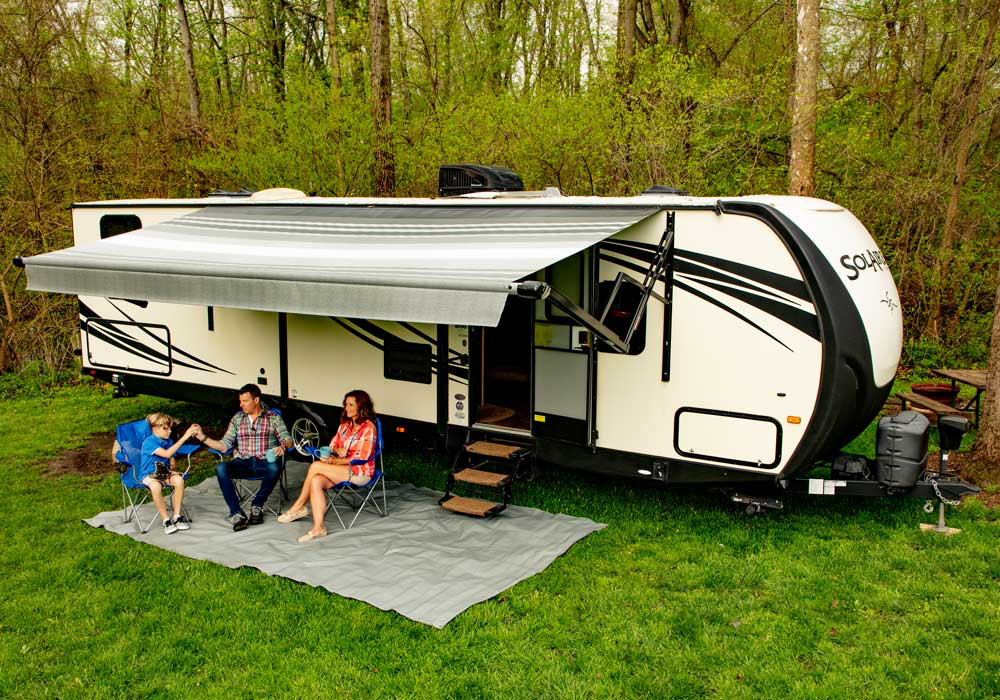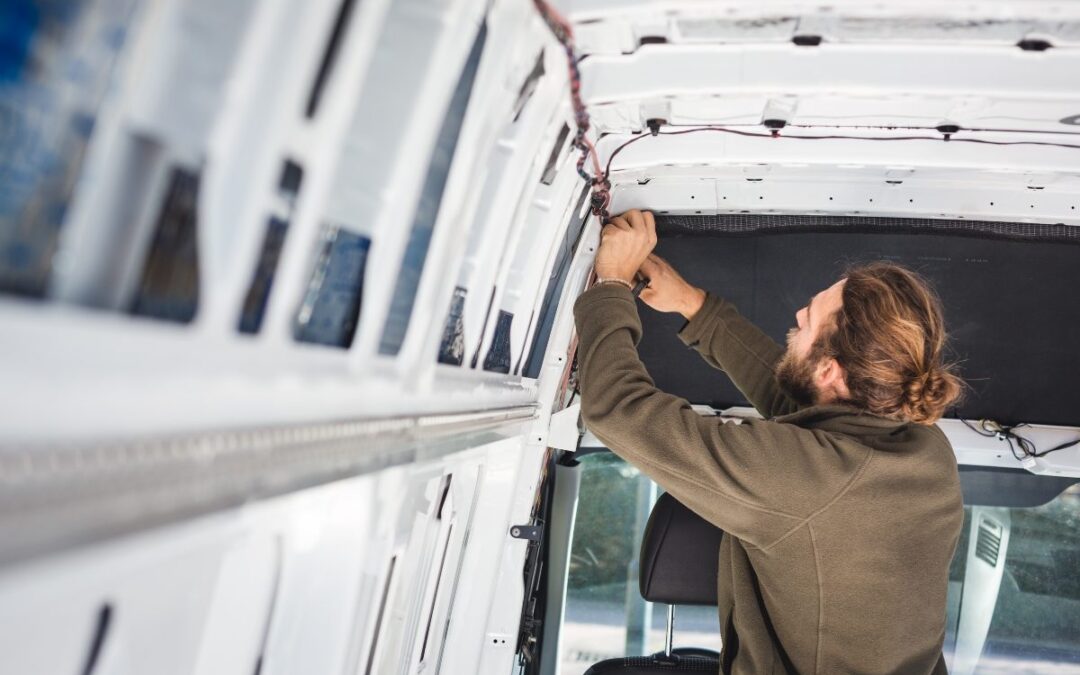Your RV awning is an important part of your setup. It creates an outdoor living space that’s cool and comfortable. But, like any hardworking feature on your rig, heavy use can cause maintenance issues to arise. Whether your awning won’t extend or retract, the arms feel unstable, or the fabric is starting to look worse for wear, it’s important to know what causes these problems and how to fix them.
Follow our expert guide to the most common RV awning problems and use these simple solutions to get back to effortless outdoor living wherever the road takes you.
What Causes RV Awning Problems?
RV awnings are exposed to intense sun, sudden wind gusts, heavy rain, and everyday mechanical wear. Over time, these conditions can lead to operational issues and cosmetic damage. Some problems are a result of user error, while others stem from aging components or lack of maintenance.
From awning arms that won’t lock to water pooling in the middle of the fabric, many issues are preventable with regular care and smart upgrades.
Top 7 RV Awning Problems and Troubleshooting Tips
1. Awning Won’t Retract or Extend
If your RV awning won’t move, the first step is to determine whether it’s a power or manual awning. For electric awnings, this could be a sign of motor failure, dead wiring, or a blown fuse. For manual models, check for jams or misaligned tracks.
Troubleshooting Tips:
- Check the power source and circuit breakers
- Inspect gears and roller tubes for obstruction
- Apply silicone lubricant to tracks if dry or sticky
- For manual awnings, verify that the locking mechanism is fully disengaged
Preventing this issue starts with routine testing and keeping components clean and lubricated.
2. Torn, Frayed, or Mildewed Awning Fabric
Awning fabric is constantly exposed to the sun. Over time, even UV-resistant material can weaken. Tears and fraying often start at the edges or seams. Mildew builds up when the awning is rolled up while damp.
What to Do:
- Replace your awning before it starts to show wear and tear damage with an RV Canopy Replacement
- Stains or mildew may require a gentle fabric cleaner and a soft-bristle brush
- Replace the entire fabric panel if it is brittle, severely faded, or pulling away from the arms
To extend fabric life, always allow the awning to fully dry. If you need to roll it up while wet, be sure to extend and thoroughly clean and dry the awning when possible to prevent mold and mildew.
3. Motor or Electrical Issues
Power awnings rely on a small motor to operate smoothly. If your awning is slow, noisy, or not moving at all, the motor may be failing or disconnected.
Check for:
- Loose or corroded wiring
- Faulty wall switches
- Burned-out fuses
- Intermittent or low power supply
You may need to consult your awning’s service manual or a certified technician for electrical testing.
4. Uneven or Crooked Awning Deployment
If your awning extends unevenly or looks crooked when deployed, the arms or roller tube may be out of alignment. This can cause stress on the fabric and eventually lead to tears or uneven retraction.
Fixes Include:
- Retract the awning and extend it again slowly to see where it sticks
- Inspect the arms for bending or damage
- Ensure the canopy is evenly positioned and the polycard secured with a set screw or fastener at the roller tube and awning rail to keep it from shifting over time.
Carefree awning systems are designed to deploy evenly every time, reducing stress on your setup.
5. Awning Arms Won’t Lock or Stay in Place
When the awning arms are loose or refuse to lock, it makes your setup vulnerable to wind and weather. The arms may be worn, or the locking mechanisms might be stripped or dirty.
What You Can Do:
Functional and maintained awning arms are critical for safety and long-term performance.
6. Water Pooling and Sagging Awning
One of the most common issues after heavy rain is water collecting in the middle of the awning. This not only stresses the fabric but also strains the arms and frame.
Solutions:
- Bring your slide-out room in during a rainstorm, and your room’s slide-out seals will help keep water from coming into your RV
- Retracting the room will also retract the awning and remove water from the fabric, so that it does not damage your RV
- You can put it back out right away, but you need to get the water off the fabric. This is especially true for longer slide-out awnings.
7. Noise and Vibration in Wind
Awnings that flap, vibrate, or rattle in the wind are not just noisy—they can be damaged or pulled loose in sudden gusts. Loose fabric, unsecured arms, or low-tension springs are often the cause.
To Reduce Wind Noise:
- Tighten all mounting hardware and arm joints
- Check that your fabric is in good condition with no rips, tears, or weak points
- Avoid leaving the awning extended in windy conditions
Carefree of Colorado’s advanced awning systems are precision-engineered to minimize vibration and movement, making your setup quieter and more reliable.
RV Awning Troubleshooting
Not every issue means you need a full replacement. Small fabric tears, minor misalignments, and loose components can often be repaired at home or by your RV service professional.
Replace or repair your awning if:
- The fabric is brittle, rotted, or pulling away from the roller
- The motor repeatedly fails even after fuse or wiring replacement
- Awning arms are bent or unable to support the structure safely
When you’re ready to upgrade, look for high-performance materials, durable arms, and an intuitive design. Carefree awnings are built to last and engineered for seamless operation.
Keep Your RV Awning Performing Like New
Your awning is a key part of your outdoor adventure setup. Regular inspections, careful storage, and smart upgrades go a long way in preventing problems and ensuring years of comfort on the road.
Whether you need a replacement, an upgrade, or parts to keep your current system in peak condition, Carefree of Colorado offers intuitive, dependable solutions that are built for performance and designed for adventure.

